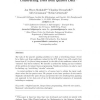Free Online Productivity Tools
i2Speak
i2Symbol
i2OCR
iTex2Img
iWeb2Print
iWeb2Shot
i2Type
iPdf2Split
iPdf2Merge
i2Bopomofo
i2Arabic
i2Style
i2Image
i2PDF
iLatex2Rtf
Sci2ools
CANDC
2005
ACM
2005
ACM
Integer linear programming as a tool for constructing trees from quartet data
The task of the quartet puzzling problem is to find a best-fitting binary X-tree for a finite n-set from confidence values for the 3 n 4 binary trees with exactly four leaves from X, its fitness being measured by the sum of the confidence values of all "induced" four-leaves subtrees. We describe a method for finding an exact solution of this problem by integer linear programming. Similar procedures can also be used for finding, e.g., best-fitting "circular" networks. A crucial problem in this context is, of course, how to obtain the input confidence values for the quartet trees. We propose to use inner products of rate-matrix diagonals calculated for pairs of taxa and present the trees resulting from applying our approach to two data sets of up to 36 mitochondrial sequences of mammals including an outgroup. Key words: weighted quartet, integer linear programming, observed rate matrix, Mammals' mitochondrial evolution, phylogeny This paper is based on ideas tha...
CANDC 2005 | Emerging Technology | Integer Linear Programming | Linear Programming | Quartet Puzzling Problem |
Related Content
| Added | 15 Dec 2010 |
| Updated | 15 Dec 2010 |
| Type | Journal |
| Year | 2005 |
| Where | CANDC |
| Authors | Jan Weyer-Menkhoff, Claudine Devauchelle, Alexander Grossmann, Stefan Grünewald |
Comments (0)

